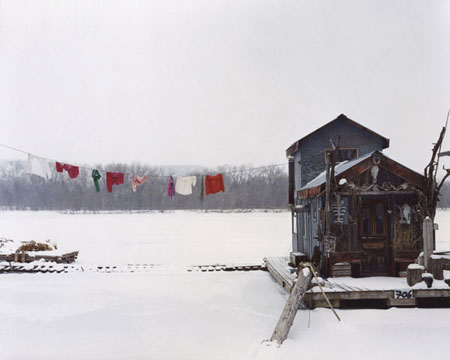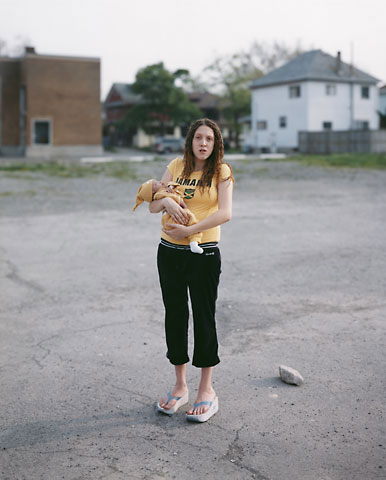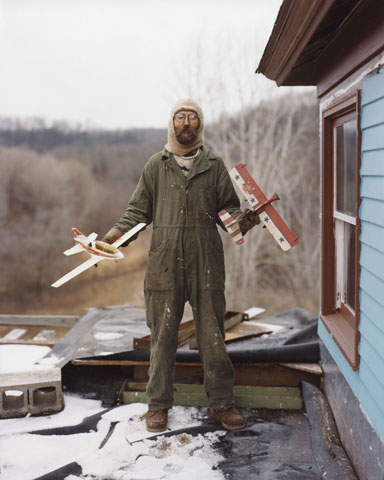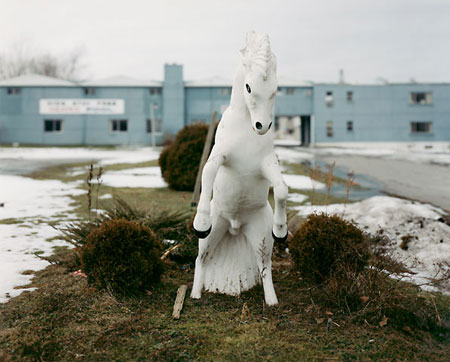A Conversation with Alec Soth

A few years back, Alec Soth’s Sleeping By the Mississippi took the photo world by storm. The book became one of those rare instant classics and a fine example of what contemporary photography can be about. With his next book, Niagara, published earlier this year, Alec managed to surprise a lot of people because of the subject matter. Just like “Mississippi”, “Niagara” contains an interesting mix of portraits, landscapes, interiors of buildings, and still lifes. Being a fan of his work, I was delighted when Alec agreed to talk with me about his work.
Jörg Colberg: Your projects contain an interesting mix of portraits, still lifes, and landscapes, which I personally find quite interesting. Often, photographers focus on either portraits or on landscapes for a project. How do you decide what you want to do for a project? How well do you have a project mapped out when you work on it? For example, the ‘Niagara’ project even contains photos of love letters - did you plan including those in advance?
Alec Soth: First let me address the diversity of subject matter because this is really important to me. A long time ago I became conscious of branding. It exists in the art world and just about ever other field. You can’t avoid it. No matter what kind of work you do, most people are going to boil it down to one sentence. “He’s the guy who photographs Weimaraners” or “She makes digitally altered pictures of creepy looking children.” Whatever. I don’t think an artist can entirely control what that sentence will be, but they can be aware of it. And I didn’t want to be branded for photographing one kind of thing. I love photographing people, places…. everything. I didn’t want to be locked into one thing. Regarding the mapping out of projects, I try to keep the process intuitive. For me the excitement of photography is wandering and discovery. With ‘Niagara’ I started with the idea of love, but I really didn’t know how to get at it. In the beginning I used the US and Canadian border towns as a metaphor for a couple (Love Canal on one side, casinos on the other). It was a disaster. It took a long time to come to the idea of the letters.

JC: I have the feeling that many people will not realize that photography, when done with the intent of creating art - to separate it from purely editorial or documentary work, say - takes a lot of time, and there is a lot of very hard work involved. Which is not to say that editorial work is less work or easier. I would be curious to learn what your own experiences with editorial work are. I can imagine it might not be easy to switch between the two modes - or is it?
AS: I am able to make the switch pretty easily, but they are indeed two entirely different ways of working. A huge part of my personal work is finding my subject. This involves daydreaming, wandering, editing and reshooting… it takes forever. The process is introspective and I always work alone. With editorial photography the subject is handed to me on a platter. The editor usually tells me to go take a picture of ‘x’. A lot of the art is stripped out of the process. The only thing that is left is the technical job of making a great picture. Because time is limited, I usually require the help of assistants.
So why do I do editorial photography? It certainly isn’t for the money. First, I believe it is healthy to do work outside of the art world. I don’t trust art world success. Take a look at a 15 year old Whitney Biennial catalogue and see how many names you recognize. It all seems so trendy and fleeting. Moreover, I like to participate in the public discourse. I have a real hermetic streak and often fantasize about holing up in a cabin in Nova Scotia to do finger-painting. Assignment work keeps me going out into the world to meet people and make pictures. Finally, magazine work is just good practice. I once had a great conversation about this with Robert Polidori. Robert used to play in a rock band. He said that editorial work is like going on the road. Often you are playing in an empty bar in a nowhere town and wonder ‘why am I doing this?’ All of those gigs make you stronger - more ready for the big gigs, the arenas and the studio sessions.

JC: Something that we talked about before is how to approach people for portraits. How do you go about this? In particular, if you are interested in doing nude work?
AS: It isn’t too complicated. I drive around. I sit in donut shops. Walk malls. I look at people. Once in awhile someone catches my eye. Why? It is a hard thing to describe, but I think it is similar to the feeling you get when you see, you know, the attractive person across a crowded bar. Why is that person attractive to you? Some of it is culture, some of it is your own upbringing, etc. It is personal. I’m kind of tuned into this attraction. And when I feel it I approach the person. It is scary. And because it isn’t ‘normal’ it is probably scarier than approaching the person across the bar. The nudes are done in much the same way. But of course there is a lot more explanation and negotiation before we take the pictures.
JC: I guess it would be somewhat “easier” to do candid portraits, without asking the subjects. Obviously, you would get different results. But there is another, particular aspect to candids that got mentioned quite often on the blog, in various contexts, and that is the question of whether people have to be asked if their portrait ends up in a gallery or book. The general feeling amongst many photographers seems to be that as long as you are in a public space, a photographer can simply take your photo. But I do think that to some extent, somebody who feel uncomfortable about having his or her photo taken and/or exhibited needs to be taken seriously. I realize this is not a very simple question, but what do you think about this?
AS: Photographing people, with or without permission, usually leads to all sorts of ethical dilemmas. It is unavoidable. I do my best to be good. I ask permission. I’m honest about how I use the pictures and send everyone I photograph a print. But the truth is that when I take a picture of a person I am ‘using’ that person. They are becoming material for my work and I’m turning them into an object, a piece of paper, that is a commodity. It is all troubling. All I can say is that on the long list of ethical crimes a misdemeanors, photographing people in the name of art isn’t the worst violation.

JC: How do you go about composing portraits? Do you tell your subjects what poses to take or do you give them the freedom to do whatever they want to do? There are some photos that are so interesting and striking - like Charles with his two model airplanes in the “Sleeping” series - that I have wondered how this portraits was taken.
AS: Again, it is an intuitive thing. Before I set up the camera, I watch them in the environment… looking to knit the two things together. Sometimes they do something like show me model airplanes and it clicks. After that I set up the camera the subject has to remain still. But a little movement goes on. I watch their eyes or the turn of their head. Again, sometimes it clicks. So I tell them to hold it, or recreate it. But because of the slow camera, I miss a lot of moments.

JC: It might just be my impression but when looking at “Sleeping” and especially at “Niagara” there’s a lot of melancholy in those images, which makes them all the more touching. This is probably not something people would expect to see, for example when being told that “Niagara” is about love. I guess you must have planned this to some extent, because otherwise you would have taken photos about love in Las Vegas - also a place where people go to get married?
AS: Well, part of it is just my attraction to things. I mean, there are a lot of skyscrapers along the Mississippi but they aren’t in my pictures. And there is a lot of pure joy in ”Niagara” but I didn’t focus on that either. It is just my sensibility. I don’t claim to be making an accurate document of a place. I’m just making my little melancholy poems.
JC: I don’t mean to be negative about photography in general, but it seems to me that there are lots of photographic clichés about the US, and I really don’t know why that is. Is it because certain places are just too inviting for photography or is it because people have strong preconceptions? This kind of phenomenon isn’t restricted to the US. For example, when one thinks about Germany the fairy castle of the Bavarian king comes to mind almost instantly. Not all photographic clichés can be avoided all that easily, I think. Your photography avoids those clichés so easily. I realize this is a little bit like asking you for your secrets but how do you avoid clichés? I guess not going to Cuba to take photos there is part of the trick, but I wonder what else a photographer can do? Or is this a silly question?
AS: Fabulous question. And while I appreciate your compliment, I always find myself brushing up against photo clichés. It is a huge battle. The reason is that photography is essentially a cliché-making machine. Once upon a time it wasn’t a cliché to photograph an old barn or white picket fence. But a thousand people did it and now it is embarrassing. But while today it makes a bad picture, millions of people now find old barns beautiful (I suspect this wasn’t the case fifty years ago). The same goes for old cars in Cuba and so many other things.
I don’t think it is healthy for a photographer to altogether run away from clichés — just as I don’t think it is wise for any kind of artist to try and do something entirely new. We are all working within a language and tradition. To avoid that language is to speak gibberish. The best thing is to accept it and maybe, if your lucky, expand it a little bit.

JC: When a viewer is involved, clichés work both ways, in that photographers might take clichéd photos, but a viewer might also expect certain things from photography. For example, if I went to Cuba and did not take photos of poor people in fancy 1950s cars, people might lose interest in the photography. In a similar fashion, people might complain if you don’t show them something they have come to expect or if you show the place they live in in what they think is a bad light. For a photographer, it can become quite tricky to find a good balance. Have you had people complaining about photos you took along the Mississippi? And how do you deal with these kinds of expectations that people might have?
AS: I’ve had negative criticism of my depiction of both ‘Niagara’ and ‘Mississippi’. It is hard to say how I deal with it. I would be lying if I said it doesn’t affect me in some way. I just try not to fixate on it. I know that when I’m looking for new pictures, all of that stuff falls away. I’m really able to focus on my own longing.
 By
By